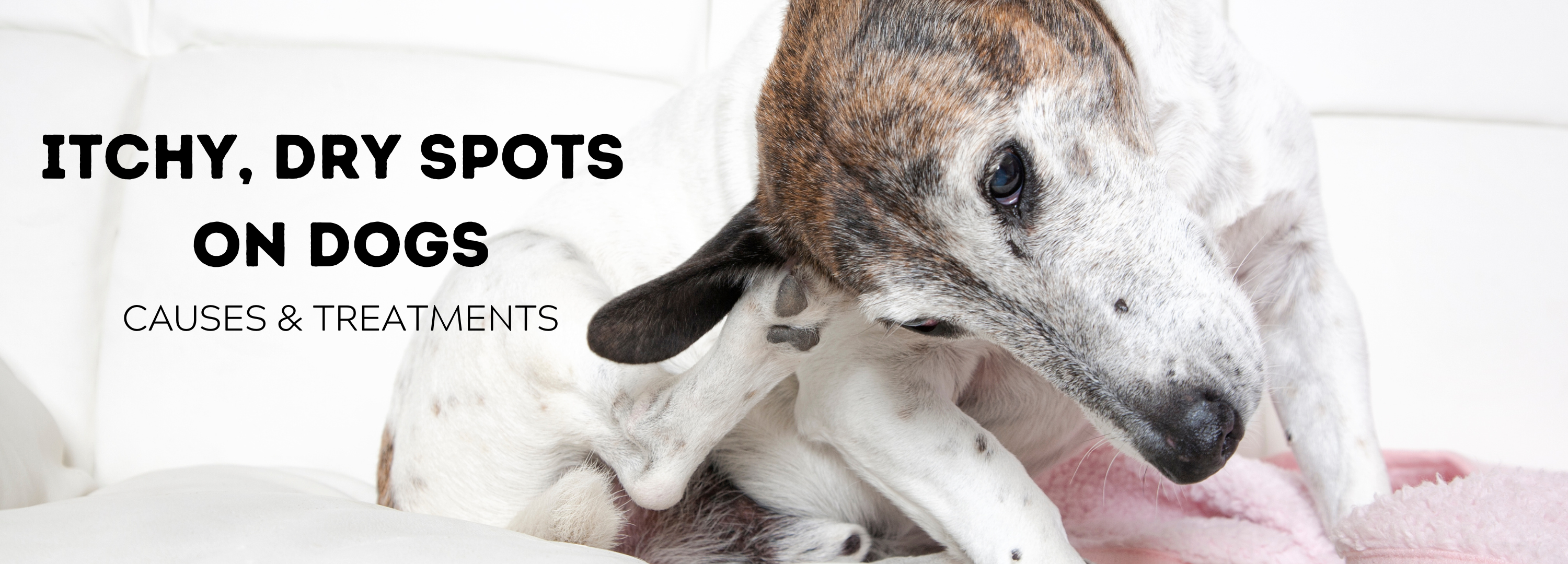Your Cart is Empty
🐾 FREE SHIPPING ON ORDERS OVER $99 🐾
🐾 FREE SHIPPING ON ORDERS OVER $99 🐾
🐾 FREE SHIPPING ON ORDERS OVER $99 🐾
August 02, 2022 4 min read

Dogs are occasionally susceptible to the seasonal dangers of dry skin, just like we humans are. During the Winter or when exposed to a lot of wind or dry air, this typically occurs. There is no cause for concern if dry skin is just accompanied by slight itching and flaking, but additional symptoms or indications of pain could point to a more serious condition.
While there are many possible causes of your dog's dry skin, some of them are simple to address while others are more difficult.
Dry patches can also show up as a variety of different symptoms, including;
Dry skin can occur as the weather changes or even when the circumstances in a dog's indoor surroundings change. According to Dr. Juliette Bouillon, an assistant professor at Ross University School of Veterinary Medicine, "Dry skin in dogs can be related to environmental changes, such as cold weather in the winter [or low air humidity].

As with people, dogs can develop allergies. Dogs can have a wide range of symptoms, including dry skin, from food allergies, environmental allergies, and seasonal allergies to things like pollen, dust, feathers, grass, animal dander, grain, and flea saliva. Atopic dermatitis, a skin disorder that causes dry skin, itching, redness, and inflammation as well as the potential for secondary skin infections, can develop from these allergies if they are not addressed.
Dry skin in dogs can also result from nutritional deficits. There may not be enough fatty acids in your dog's diet to maintain healthy skin. If you give your dog a homemade diet, see a veterinary nutritionist to develop a recipe that fully satisfies all of his requirements; never rely entirely on recipes you find online.
Obviously we are big advocates for consistent bathing of our four-legged friends, but there is such a thing as too often. The ‘good’ oils on your dog's skin may be stripped away as a result, leaving it vulnerable and dry. Most dogs only need to be bathed on an ‘as needed’ basis. Check with your veterinarian to discover whether your dog has a skin problem that is producing the symptoms you're seeing if you find yourself bathing your dog more regularly because of odour or grease build up.
It’s icky, we know, but another possible factor in dogs' dry skin are parasites. Canine scabies, canine cheyletiellosis (walking dandruff), and the Demodex mite are examples of parasites that can cause mange. Dry, flaky skin can also be an indication that your dog has lice. A trip to the vet is necessary for the diagnosis of parasites in dogs that cause dry skin. If your family veterinarian determines that your pet needs veterinary dermatology care, he or she may recommend a specialist to you.

Vitamin E oil can be applied directly to the affected skin area rather than being absorbed internally. That skin can be swiftly restored to health with a little massage and even a bath in water that contains vitamin E oil. You must use caution if you decide to feed your pet vitamin E internally. Different vitamin amounts are needed for various dog breeds. A veterinarian can advise you on the appropriate dosage.
You could even find a Moisturising Balm or Dog Cologne that already contains Vitamin E (hint; all of ours do).
Dr. Richter advises using a quality conditioner after checking that your dog's shampoo is gentle and nourishing (human shampoo has an incorrect pH). Don't blow dry your pet's coat after shampooing. “ Richter points out that even chilly blow dryers will dry the coat. "Your pet will naturally take care of the remainder. Toweling down and blotting to absorb the majority of the moisture will be successful enough."
After a thorough rinsing, give them a bath and use an oatmeal-based shampoo. As a colloid, oatmeal is soothing to the skin.

Talk to your veterinarian about a nutrition plan and any supplements he suggests so that you can provide your dog the nutrients they need for a healthy coat and skin by switching to a high-quality diet.
To help your pet's hair and skin, think about adding supplements like probiotics and Hemp Seed Oil to their diet. Your pet will drink more water and have softer skin if you give them some wet food and plenty of fresh water.
For your pet, this applies both inside and outside. Low humidity can exacerbate dry skin. It is not a terrible idea to keep the dog indoors as much as you can during winter when it becomes cold. However, it might be just as dry inside. Because of this, purchasing a humidifier will aid in preventing dry skin issues in your pet.
Some other at-home tips you could try include;

The aforementioned at-home remedies can all be applied to your dog's dry skin. Another possibility is that the dog is reacting allergic to something. Making plans for a visit to the vet will aid in developing a plan for treating the dry skin. The good news is that no major surgery or therapy is involved with this. Most of the time, employing one or two of our tips above will be sufficient to treat your dog's dry skin.